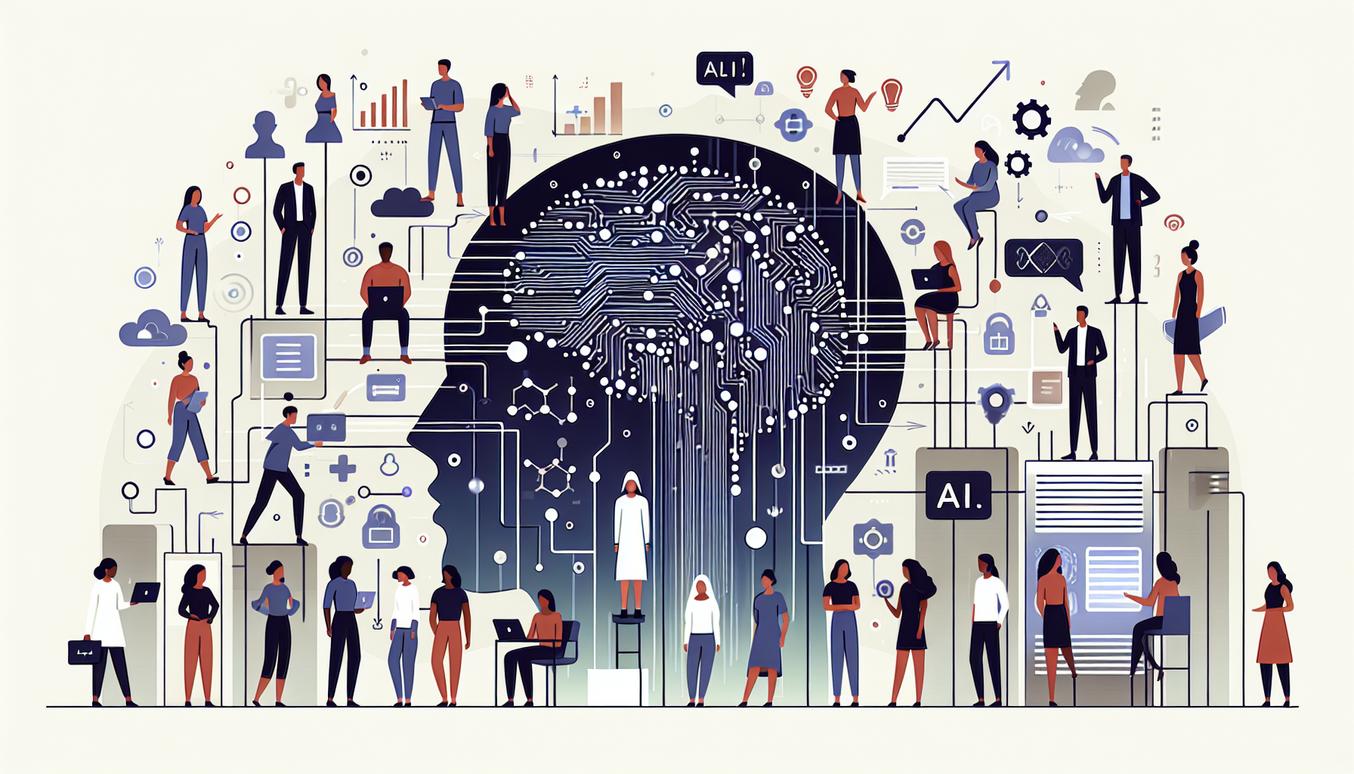A Strategic Guide to AI Innovation: From Concept to Ethical Deployment
Table of Contents
- Introduction — Reframing AI Innovation for Strategic Impact
- Landscape — Core Technologies and Emerging Breakthroughs
- Practical Design — From Prototype to Responsible Deployment
- Applied Examples — Cross industry Use Cases
- Roadmap — Building an Ethical Innovation Program
- Tools and Templates — Checklists and Decision Guides
- Conclusion — Strategic Next Moves
- Appendix — Further Reading and Resources
Introduction — Reframing AI Innovation for Strategic Impact
Artificial Intelligence has moved beyond the realm of theoretical research and into the core of modern business strategy. For technology leaders, product managers, and strategists, the conversation is no longer about *if* they should adopt AI, but *how* to do so effectively, responsibly, and sustainably. True AI innovation is not merely about implementing the latest algorithm; it is a holistic process that integrates technological capability with ethical foresight and clear business objectives. It involves creating systems that are not only powerful but also fair, transparent, and trustworthy.
This guide reframes the concept of AI innovation from a purely technical challenge to a strategic, socio-technical discipline. We will move beyond the hype to provide a practical framework for navigating the AI landscape, from understanding core technologies to deploying them responsibly. By focusing on an ethics-first approach and concrete implementation checkpoints, this article equips you to lead your organization in building AI solutions that deliver lasting value and build user trust, positioning your efforts at the forefront of sustainable AI innovation.
Landscape — Core Technologies and Emerging Breakthroughs
To effectively strategize, leaders must first understand the foundational technologies driving the current wave of AI innovation. While the field is vast and rapidly evolving, three core areas represent the primary engines of progress today. Understanding their capabilities and limitations is the first step toward identifying viable and impactful applications.
Neural Networks and Deep Learning Advances
At the heart of modern AI are Artificial Neural Networks, computational models inspired by the human brain. Deep Learning, a subfield involving networks with many layers, has been responsible for breakthroughs in areas like image recognition, speech processing, and complex pattern detection. Recent advances are focused on creating more efficient and adaptable architectures, such as Transformers, which have proven exceptionally powerful beyond their original use in language. This continuous improvement in model architecture is a key driver of AI innovation, enabling more complex problems to be solved with greater accuracy and less computational overhead.
Generative Systems and Language Models
Generative AI, particularly Large Language Models (LLMs), has captured the public imagination and transformed business processes. These systems are trained on vast datasets to generate new content, from text and code to images and audio. Their capabilities in Natural Language Processing (NLP) enable sophisticated applications like advanced chatbots, content summarization tools, and automated code generation. The frontier of AI innovation here is moving toward multimodal models, which can understand and generate content across different data types simultaneously, opening up new possibilities for human-computer interaction and creative problem-solving.
Reinforcement Learning and Autonomous Systems
Reinforcement Learning (RL) is a paradigm where an AI agent learns to make optimal decisions by performing actions and receiving rewards or penalties. Unlike supervised learning, it does not require a labeled dataset. This makes it ideal for dynamic and complex environments. RL is the technology behind advancements in autonomous systems, from robotic process automation and supply chain optimization to sophisticated game-playing agents. As a driver of AI innovation, RL holds immense promise for solving complex optimization problems where the optimal path is not known in advance.
Practical Design — From Prototype to Responsible Deployment
An idea for AI application is only the beginning. The journey from a promising prototype to a robust, responsibly deployed system requires a disciplined and structured approach. This phase is where true, sustainable AI innovation is forged, ensuring that solutions are not only effective but also safe, fair, and reliable.
Data Practices and Feature Strategy
Data is the lifeblood of most AI systems. The quality, relevance, and integrity of your data directly determine the performance and fairness of your model. A robust data strategy is non-negotiable.
- Data Sourcing and Quality: Ensure data is collected ethically and is representative of the user population to avoid inherent biases. Invest in rigorous data cleaning and validation processes.
- Feature Engineering: The process of selecting and transforming variables for the model is critical. This step often requires deep domain expertise to identify signals that are truly predictive and not just correlated with protected attributes like race or gender.
- Privacy and Security: Implement privacy-preserving techniques, such as data anonymization or differential privacy, from the outset. Secure data storage and access controls are fundamental.
Evaluation Metrics and Robustness Testing
Success cannot be measured by a single accuracy score. A comprehensive evaluation framework is essential for understanding a model’s real-world behavior and building trust. This is a critical checkpoint for any serious AI innovation initiative.
- Beyond Accuracy: Define and monitor metrics for fairness, ensuring the model performs equitably across different user subgroups. Track precision, recall, and other metrics relevant to the specific business problem.
- Robustness Testing: Actively test the model’s resilience. This includes testing against adversarial attacks (deliberately crafted inputs to fool the model), data drift (changes in input data over time), and edge cases.
- Interpretability: Use tools and techniques from Explainable AI (XAI) to understand *why* a model is making certain decisions. This is crucial for debugging, accountability, and user trust.
Governance, Transparency and Responsible AI
A commitment to Responsible AI must be operationalized through a formal governance structure. This framework ensures that ethical principles are embedded throughout the entire AI lifecycle.
- Establish an AI Governance Committee: Create a cross-functional team including legal, ethics, product, and engineering experts to oversee AI projects and set internal policies.
- Maintain Documentation: Keep detailed records of data sources, model architectures, training procedures, and evaluation results. This transparency is vital for auditing and accountability.
- Human-in-the-Loop: For high-stakes applications, design systems that include meaningful human oversight. Determine clear points where a human can review, override, or stop an AI-driven decision.
Applied Examples — Cross industry Use Cases
The impact of AI innovation is not confined to a single sector. Across industries, organizations are leveraging these technologies to solve complex problems and create new value. The following nonproprietary examples illustrate the breadth of application.
| Industry | Use Case | AI Technology Applied | Strategic Impact |
|---|---|---|---|
| Healthcare | Medical Image Analysis | Deep Learning (Convolutional Neural Networks) | Assists radiologists in detecting diseases in X-rays and MRIs with higher speed and accuracy, enabling earlier intervention. |
| Finance | Algorithmic Fraud Detection | Predictive Modelling and Anomaly Detection | Identifies and flags potentially fraudulent transactions in real-time, significantly reducing financial losses and protecting customers. |
| Retail | Hyper-Personalized Recommendations | Collaborative Filtering and Reinforcement Learning | Improves customer experience and increases sales by suggesting products tailored to individual browsing and purchasing behavior. |
| Manufacturing | Predictive Maintenance | Predictive Modelling (Time-Series Analysis) | Analyzes sensor data from machinery to predict equipment failures before they occur, reducing downtime and maintenance costs. |
Roadmap — Building an Ethical Innovation Program
Integrating ethics into your AI innovation pipeline requires a deliberate, phased approach. A forward-looking roadmap ensures that responsible practices are not an afterthought but a core component of your strategy. Here is a sample roadmap for an organization starting in 2025.
- Phase 1: Foundational Setup (2025)
- Objective: Establish the governance and principles for responsible AI.
- Key Actions: Form a cross-functional AI ethics board. Draft and ratify a set of organizational AI principles (e.g., fairness, accountability, transparency). Conduct an initial audit of existing AI systems for potential ethical risks.
- Phase 2: Integration and Training (2026)
- Objective: Embed ethical checkpoints directly into the product development lifecycle.
- Key Actions: Develop and deploy mandatory ethical AI training for all product managers, data scientists, and engineers. Integrate “Fairness and Bias” assessments as a required step in the model validation process. Introduce “AI Fact Sheets” for documenting every deployed model.
- Phase 3: Continuous Auditing and Adaptation (2027 and Beyond)
- Objective: Ensure long-term compliance, adaptability, and continuous improvement.
- Key Actions: Implement automated systems for monitoring production models for performance drift and emergent bias. Conduct regular third-party audits of high-risk AI systems. Establish a clear process for adapting to new regulations and evolving societal norms around AI.
Tools and Templates — Checklists and Decision Guides
To make ethical AI practical, teams need simple, actionable tools. These templates can be adapted to your organization’s specific needs to guide decision-making and ensure consistency in your AI innovation process.
AI Project Initiation Checklist
- Problem Definition: Is the business problem clearly defined? Have we considered if AI is the most appropriate solution?
- Data Assessment: Have we identified the necessary data? Have we assessed its quality, representativeness, and potential for bias? Have we confirmed we have the rights to use it?
- Stakeholder Impact: Who will be affected by this system (users, employees, society)? Have we considered potential negative impacts on any group?
- Ethical Risk Identification: Have we performed an initial risk assessment for fairness, privacy, safety, and transparency?
- Success Metrics: Are success metrics defined? Do they include measures of both performance and fairness?
Ethical Risk Assessment Matrix
| Risk Category | Potential Impact Example | Mitigation Strategy |
|---|---|---|
| Bias and Fairness | A loan approval model unfairly disadvantages applicants from a specific demographic. | Test model performance across demographic subgroups. Use bias mitigation techniques during pre-processing or in-processing. |
| Privacy | User data from a recommendation engine is exposed or used for unintended purposes. | Implement data anonymization. Enforce strict access controls. Conduct a privacy impact assessment. |
| Transparency | Users or operators do not understand why the AI system made a specific high-stakes decision. | Use explainable AI (XAI) techniques like SHAP or LIME. Provide clear documentation and user-facing explanations. |
| Safety and Robustness | An autonomous vehicle’s perception system fails in adverse weather conditions. | Conduct extensive testing in simulated and real-world edge cases. Implement fail-safe mechanisms and human oversight protocols. |
Strategic Next Moves
The journey of AI innovation is a marathon, not a sprint. While the technological landscape will continue to shift, the principles of responsible, strategic implementation will remain constant. Success is no longer defined solely by algorithmic performance but by the ability to build AI systems that are effective, trustworthy, and aligned with human values. The most impactful AI innovation will come from organizations that treat ethics not as a compliance checkbox but as a core driver of design and strategy.
For technology leaders, the immediate next move is clear: begin building the organizational capacity for responsible innovation. Start by establishing a governance framework, educating your teams, and integrating ethical checkpoints into your existing workflows. By fostering a culture that prioritizes both technological excellence and ethical responsibility, you can guide your organization to develop AI solutions that are not only powerful but also profoundly beneficial.
Appendix — Further Reading and Resources
To deepen your understanding of the topics discussed, we recommend exploring these concepts and frameworks from reputable, non-commercial sources:
- NIST AI Risk Management Framework: A voluntary framework developed by the U.S. National Institute of Standards and Technology that provides a structured process for managing risks associated with AI systems.
- The OECD AI Principles: An intergovernmental standard promoting AI that is innovative, trustworthy, and respects human rights and democratic values. They have been adopted by numerous countries.
- Papers on Algorithmic Fairness: Academic research on fairness metrics (e.g., demographic parity, equalized odds) provides a deep technical foundation for evaluating and mitigating bias in machine learning models.
- Explainable AI (XAI) Research: The body of work around techniques like LIME (Local Interpretable Model-agnostic Explanations) and SHAP (SHapley Additive exPlanations) offers practical methods for interpreting complex model decisions.









